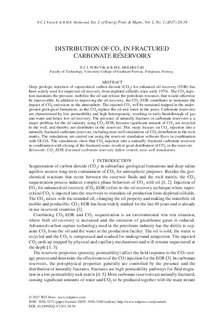Distribution Of Co2 In Fractured Carbonate Reservoirs
Journal article, Peer reviewed
Published version
Permanent lenke
http://hdl.handle.net/11250/2468613Utgivelsesdato
2017Metadata
Vis full innførselSamlinger
Originalversjon
International Journal of Energy Production and Management. 2017, 2 (1), 28-38. 10.2495/EQ-V2-N1-28-38Sammendrag
Deep geologic injection of supercritical carbon dioxide (CO 2 ) for enhanced oil recovery (EOR) has been widely used for improved oil recovery from depleted oilfields since early 1970s. The CO 2 injec - tion maintains the pressure, mobilize the oil and release the petroleum resources that would otherwise be inaccessible. In addition to improving the oil recovery, the CO 2 -EOR contributes to minimize the impact of CO 2 -emissions to the atmosphere. The injected CO 2 will be remained trapped in the under - ground geological formations, as the CO 2 replace the oil and water in the pores. Carbonate reservoirs are characterized by low permeability and high heterogeneity, resulting in early breakthrough of gas and water and hence low oil recovery. The presence of naturally fractures in carbonate reservoirs is a major problem for the oil industry using CO 2 -EOR, because significant amount of CO 2 are recycled to the well, and thereby not distributes in the reservoir. This study focuses on CO 2 injection into a naturally fractured carbonate reservoir, including near-well simulations of CO 2 -distribution in the rock matrix. The simulations are carried out using the reservoir simulation software Rocx in combination with OLGA. The simulations show that CO 2 -injection into a naturally fractured carbonate reservoir in combination with closing of the fractured zones result in good distribution of CO 2 in the reservoir. Keywords: CO 2 -EOR, fractured carbonate reservoir, inflow control, near-well simulations.
